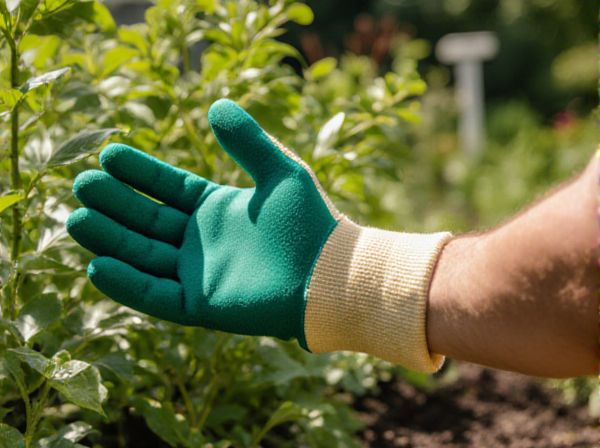
Integrated Pest Management (IPM) vs Conventional pest management Illustration
Integrated Pest Management (IPM) employs a combination of biological, cultural, mechanical, and chemical methods to control pests in an environmentally sustainable and cost-effective manner. Conventional pest management often relies heavily on chemical pesticides, which can lead to resistance, environmental contamination, and non-target species harm. IPM prioritizes long-term prevention and ecosystem balance, reducing chemical usage and promoting healthier agricultural and residential environments.
Table of Comparison
| Feature | Integrated Pest Management (IPM) | Conventional Pest Management |
|---|---|---|
| Approach | Ecological and preventive | Chemical and reactive |
| Pest Control Methods | Biological control, cultural practices, monitoring, selective pesticides | Broad-spectrum chemical pesticides |
| Environmental Impact | Minimal, promotes biodiversity | High, potential pollution and non-target harm |
| Resistance Management | Effective resistance prevention through diverse tactics | High risk of pest resistance |
| Cost Efficiency | Long-term cost savings | Short-term, often higher recurring costs |
| Health and Safety | Lower health risks due to reduced chemical use | Higher exposure risks to chemicals |
| Application Frequency | Targeted and as needed based on monitoring | Regular or scheduled applications |
| Suitability | Ideal for sustainable farming and gardening | Suitable for rapid, large-scale pest elimination |
Introduction to Pest Management Approaches
Integrated Pest Management (IPM) emphasizes sustainable pest control by combining biological, cultural, and mechanical methods with minimal chemical use to reduce environmental impact. Conventional pest management primarily relies on chemical pesticides for immediate pest eradication but often leads to resistance and ecological imbalance. IPM's holistic approach improves long-term pest control efficiency and promotes agricultural ecosystem health.
Defining Integrated Pest Management (IPM)
Integrated Pest Management (IPM) is a sustainable approach to pest control that combines biological, cultural, physical, and chemical tools in a coordinated way to minimize environmental impact and human health risks. IPM emphasizes monitoring pest populations and using targeted interventions only when pest levels exceed established thresholds. Unlike conventional pest management, which often relies heavily on routine pesticide applications, IPM seeks long-term prevention through ecosystem-based strategies.
Understanding Conventional Pest Management
Conventional pest management primarily relies on chemical pesticides to control pest populations, often leading to rapid reduction but posing risks of environmental contamination and pest resistance. This approach emphasizes immediate pest eradication without comprehensive monitoring or preventative strategies. Understanding conventional methods highlights the limitations that Integrated Pest Management (IPM) addresses through sustainable practices and ecosystem balance.
Key Principles of IPM
Integrated Pest Management (IPM) emphasizes a combination of biological, cultural, mechanical, and chemical control methods to sustainably manage pest populations, minimizing environmental impact and human health risks. Key principles of IPM include pest identification, monitoring, threshold levels for action, prevention strategies, and targeted treatments only when necessary. Unlike conventional pest management which often relies heavily on chemical pesticides, IPM prioritizes long-term ecosystem balance and the reduction of pesticide resistance.
Chemical Dependency in Conventional Methods
Conventional pest management relies heavily on synthetic chemical pesticides, leading to increased chemical dependency and potential environmental harm. Integrated Pest Management (IPM) reduces chemical use by combining biological controls, cultural practices, and targeted chemical applications, minimizing risks to ecosystems and human health. This strategic approach in IPM promotes sustainable pest control and mitigates the issues associated with pesticide resistance and residue accumulation.
Environmental Impact Comparison
Integrated Pest Management (IPM) significantly reduces environmental harm by combining biological controls, habitat manipulation, and minimal pesticide use, leading to lower chemical residues in soil and water. Conventional pest management relies heavily on synthetic chemicals, often resulting in increased toxicity, pesticide resistance, and non-target species disruption, harming biodiversity. Studies show IPM enhances ecosystem health and sustainability, making it a preferred strategy for minimizing environmental impact in agricultural pest control.
Long-Term Effectiveness and Sustainability
Integrated Pest Management (IPM) offers long-term effectiveness by combining biological, cultural, and chemical controls to reduce pest resistance and environmental impact. Conventional pest management relies heavily on chemical pesticides, which can lead to pest resistance and ecosystem disruption over time. Sustainable pest control prioritizes IPM strategies to maintain ecological balance and protect non-target species while ensuring consistent crop yields.
Human and Pet Safety Considerations
Integrated Pest Management (IPM) prioritizes human and pet safety by using targeted biological controls, habitat manipulation, and minimal chemical interventions, significantly reducing exposure to harmful pesticides. Conventional pest management often relies heavily on broad-spectrum chemical pesticides, which can pose risks of toxicity and environmental contamination. IPM strategies emphasize monitoring, prevention, and selective treatments, making it a safer and more sustainable choice for households with children and pets.
Cost Analysis: IPM vs Conventional Methods
Integrated Pest Management (IPM) offers a cost-effective alternative to conventional pest management by reducing reliance on chemical pesticides and minimizing environmental damage, which often leads to lower long-term expenditures on pest control and health impacts. Conventional methods typically incur higher immediate costs due to frequent pesticide applications, increased resistance development, and potential regulatory fines related to environmental harm. Studies show that IPM's strategic combination of biological, cultural, and mechanical controls results in significant savings and sustainable pest suppression over multiple growing seasons.
Choosing the Right Approach for Your Garden
Integrated Pest Management (IPM) offers a sustainable approach by combining biological, cultural, and mechanical controls to minimize chemical use and reduce environmental impact. Conventional pest management relies heavily on synthetic pesticides for immediate results but may lead to resistance and ecological harm over time. Selecting the right strategy depends on garden size, pest severity, and long-term ecological goals, with IPM preferred for maintaining biodiversity and soil health.
Integrated Pest Management (IPM) vs Conventional pest management Infographic

 gardendif.com
gardendif.com